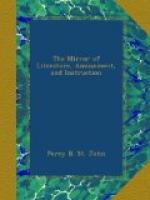The following account of the manner of speaking and voting by the Lords and Commons, is given in A Key to both Houses of Parliament:
“In the House of Lords, the Peers give their votes or suffrages, by beginning with the lowest baron; and so on with the rest, seriatim, until all have expressed their opinions; each one answering apart, ‘Content,’ or ‘Not Content.’ If the affirmatives and negatives should happen to be equal in number, the question is invariably presumed to be in the negative, (semper praesumitur pro negante,) and the Not Contents have the effect of an absolute majority. In the House of Commons, the members vote by Ayes and Noes, altogether: but if it be doubtful which is the greater number, the House divides. If the question be whether any bill, petition, &c. is to be brought into the House, then the Ayes, or approvers of the same, go out; but, if it be upon anything which the House is once possessed of, the Noes go out. Upon all questions where the House divides, the Speaker appoints four tellers—two of each opinion; who, after they have told or numbered those within, place themselves in the passage between the Bar and the door, in order to tell those who went out; who, till then, are not permitted to re-enter the House. This being done, the two tellers who have the majority take the right hand, and all four placing themselves within the bar, make three reverences as they advance towards the table, where they deliver the written numbers, saying, ’the Ayes that went out are so many: the Noes who remain are so many:’ and vice versa as it may happen. This the Speaker repeats, declaring the majority.
“In a committee of the whole House, the way of dividing is by changing sides, the Ayes taking the right, and the Noes taking the left hand of the Speaker’s chair. On such occasions there are but two tellers.
“In each House the act of the majority binds the whole. This majority is openly declared, and the votes, with the names of their authors attached, are generally published in the newspapers; so that the people at large are well enabled to judge of the conduct of their legislators and representatives. This notoriety doubtless produces a very beneficial effect in preserving the integrity of the members of both houses. It is true that when the House of Commons is about to divide, the speaker orders the gallery to be cleared, and all strangers are compelled to withdraw, that the members may be free from popular influence in giving their votes. But, as tellers are appointed to count the votes on each side, there can be no collusion or deception in the decision of any question; at the same time, this method is attended with sufficient publicity for every constitutional purpose. Indeed, it has ever been held the law, rule, and usage of the House of Commons, that all strangers are there only




